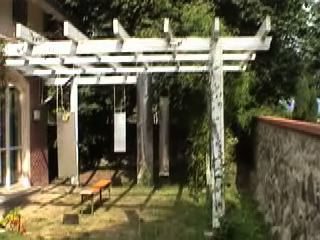Schlingen
- autoactive sound installation with metal sheets and strips , body shakers and piezo pickups
- September 2006, festival Randspiele in Zepernick
exhibition
Schlingen ("loops") was developed as site specific installation for the pergola of the parish hall of the Sankt-Annen church in Zepernick as part of the XIVth Randspiele.
Several metal sheets as well as long aluminium strips are hanging down from the top part of the wooden pergola enclosing the visitor on three sides so that they form a kind of an open but spatially limited listening room.
The sound emerges out of the network of coupled resonators: alu strips with piezo pickups, metal sheets with body shakers, electronical and mechanical connections between them as well as random controlled resonance filters in the computer. This system generates a permanent but slowly changing sound with emphasized low frequencies. Strong vibrations are clearly visible in the movements of the sheets and the hanging cords.
Once an external sound gets into these nested loops it contributes to the overall sound of the system and circulates there for a long time, but due to the strong filtering effect of the feedbacks it can't be recognized anymore.
media
sound example (on-site recording):
realization notes
The piezo pickups mounted on the long aluminium strips get the vibrations of the strips like microphones and send them electronically via a computer to two body shakers ("loudspeakers") on the opposite sides. These body shakers excite the heavy metal sheets on which they are mounted to their own resonance vibrations which in turn get transfered mechanically to the aluminium strips next to them.
Every part of this feedback system has its own resonances: sheets, strips, body shaker, pickups, cords as well as the wooden pergola and the permanently changing resonance filters within the computer.
The scheme below shows the different connections between the sound transducers: light blue for electronic connections, red for mechanical connections. The greens ones represent the delayed playback of the 4 microphon (pickup) signals over a 4th speaker which was not part of the resonance system.

